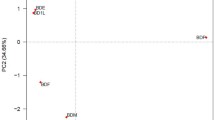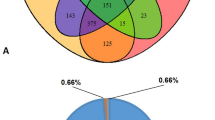Abstract
Bactrocera carambolae is a highly polyphagous fruit pest of agricultural importance. This study reports the bacterial communities associated with the developmental stages of B. carambolae. The microbiota of the developmental stages were investigated by targeted 16S rRNA gene (V3–V4 region) sequencing using the Illumina MiSeq. At 97% similarity, there were 19 bacterial phyla and unassigned bacteria, comprising 39 classes, 86 orders, 159 families and 311 genera. The bacterial composition varied among the specimens of developmental stage and across developmental stages as well as exuviae. Four phyla of bacteria (with relative abundance of ≥1% in at least one specimen)—Actinobacteria, Bacteroidetes, Firmicutes and Proteobacteria—were recovered from the larva, pupa, adult stages and exuviae. Proteobacteria was the predominant phylum in all the developmental stages as well as the exuviae. Enterobacteriaceae (Proteobacteria) was the predominant family in the adult flies while the family [Weeksellaceae] (Bacteroidetes) was predominant in the larval and pupal stages. Among the genera occurring in more than one developmental stage of B. carambolae, Erwinia was more abundant in the larval stage, Halomonas more abundant in adult female, Stenotrophomonas more abundant in adult male, and Chryseobacterium more abundant in the larval and pupal stages. The results indicate transmission of bacteria OTUs from immatures to the newly emerged adults, and from exuviae to the environment.




Similar content being viewed by others
References
Andongma AA, Wan L, Dong Y-C, Li P, Desneux N, White JA, Niu C-Y (2015) Pyrosequencing reveals a shift in symbiotic bacteria populations across life stages of Bactrocera dorsalis. Sci Rep 5:9470
Andrews S (2010) FastQC: a quality control tool for high throughput sequence data. http://www.bioinformatics.babraham.ac.uk/projects/fastqc
Ben-Yosef M, Aharon Y, Jurkevitch E, Yuval B (2010) Give us the tools and we will do the job: symbiotic bacteria affect olive fly fitness in a diet-dependent fashion. Proc R Soc B 277:1545–1552
Caporaso JG, Kuczynski J, Stombaugh J, Bittinger K, Bushman FD, Costello EK, Fierer N, Pena AG, Goodrich JK, Gordon JI et al (2010) QIIME allows analysis of high-throughput community sequencing data. Nat Methods 7(5):335–336
Cheng D, Guo Z, Riegler M, Xi Z, Liang G, Xu Y (2017) Gut symbiont enhances insecticide resistance in a significant pest, the oriental fruit fly Bactrocera dorsalis (Hendel). Microbiome 5:13
DeSantis TZ, Hugenholtz P, Larsen N, Rojas M, Brodie EL, Keller K, Huber T, Dalevi D, Hu P, Andersen GL (2006) Greengenes, a chimera-checked 16S rRNA gene database and workbench compatible with ARB. Appl Environ Microbiol 72:5069–5072
Edgar RC (2010) Search and clustering orders of magnitude faster than BLAST. Bioinformatics 26(19):2460–2461
Edgar RC, Haas BJ, Clemente JC, Quince C, Knight R (2011) UCHIME improves sensitivity and speed of chimera detection. Bioinformatics 27(16):2194–2200
Estes AM, Hearn DJ, Burrack HJ, Rempoulakis P, Pierson EA (2012) Prevalence of Candidatus Erwinia dacicola in wild and laboratory olive fruit fly populations and across developmental stages. Environ Entomol 41(2):265–274
Hadapad AB, Prabhakar CS, Chandekar SC, Tripathi J, Hire RS (2016) Diversity of bacterial communities in the midgut of Bactrocera cucurbitae (Diptera: Tephritidae) populations and their potential use as attractants. Pest Manag Sci 72:1222–1230
Khan M, Malin AA, Pramanik MK, Akter H (2014) Identification of gut bacterial community and their effect on the fecundity of pumpkin fly, Bactrocera tau (Walker). J Entomol 11(2):56–67
Khang TF, Soo OYM, Tan WB, Lim LHS (2016) Monogenean anchor morphometry: systematic value, phylogenetic signal, and evolution. Peer J 4:e1668
Klindworth A, Pruesse E, Schweer T, Peplles J, Quast C, Horn M, Glöckner FO (2013) Evaluation of general 16S ribosomal RNA gene PCR primers for classical and next-generation sequencing-based diversity studies. Nucleic Acids Res 41:1
Kounatidis I, Crotti E, Sapountzis P, Sacchi L, Rizzi A, Chouaia B, Bandi C, Alma A, Daffonchio D, Mavragani-Tsipidou P, Bourtzis K (2009) Acetobacter tropicalis is a major symbiont of the Olive fruit fky (Bactrocera oleae). Appl Environ Microbiol 75(10):3281–3288
Lemos LDN, Adaime R, De Jesus-Barros CR, De Deus EDG (2014) New hosts of Bactrocera carambolae (Diptera: Tephritidae) in Brazil. Fla Entomol 97(2):841–843
Morrow JL, Frommer M, Sherman DCA, Riegler M (2015) The microbiome of field-caught and laboratory-adapted Australian tephritid fruit fly species with different host plant use and specialisation. Microb Ecol 70:498–508
Prabhakar CS, Sood P, Kanwar SS, Sharma PN, Kumae A, Mehta PK (2013) Isolation and characterization of gut bacteria of fruit fly, Bactrocera tau (Walker). Phytoparasitica 41:193–201
Pramanik MK, Abdullah-Al-Mahin Khan M, Miah AB (2014) Isolation and identification of mid-gut bacterial community of Bactrocera dorsalis (Hendel) (Diptera: Tephritidae). Res J Microbiol 9(6):278–286
Reddy K, Sharma K, Singh S (2014) Attractancy of culturable bacteria from the gut of peach fruit fly, Bactrocera zonata (Saunders). Phytoparasitica 42:608–691
Shi Z, Wang L, Zhang H (2012) Low diversity bacterial community and the trapping activity of metabolites from cultivable bacteria species in the female reproductive system of the oriental fruit fly, Bctrocera dorsalis Hendel (Diptera: Tephritidae). Int J Mol Sci 13:6266–6278
Sood P, Nath A (2002) Bacteria associated with Bactrocera sp. (Diptera: Tephritidae)—isolation and identification. Pest Manag Econ Zool 10:1–9
Sood P, Nath A (2005) Colonization of marker strains of bacteria in fruit fly, Bactrocera tau. Indian J Agric Res 39:103–109
Thaochan N, Drew RAI, Hughes JM, Vijaysegaran S, Chinajariyawong A (2010) Alimentary tract bacteria isolated and identified with API-20E and molecular cloning techniques from Australian tropical fruit flies, Bactrocera cacuminata and B. tryoni. J Insect Sci 10:131
Thaochan N, Anuchit C, Drew R (2010) Classical and molecular study of gut bacterial community structure in alimentary tract of Bactrocera cucurbitae (Coquillett). In: Proceedings of the 8th International Symposium on Fruit Flies of Economic Importance, Valencia, pp 57–79
Thaochan N, Sittichaya W, Sausa-ard W, Chinajariyawong A (2013) Incidence of Enterobacteriaceae in the larvae of the polyphagous insect Bactrocera papayae Drew & Hancock (Diptera: Tephrotidae) infesting different host fruits. Philipp Agric Sci 96(4):384–391
Vargas RI, Piñero JC, Leblanc L (2015) An overview of pest species of Bactrocera fruit flies (Diptera: Tephritidae) and the integration of biopesticides with other biological approaches for their management with a focus on the Pacific Region. Insects 6:297–318
Wang A, Yao Z, Zheng W, Zhang H (2014) Bacterial communities in the gut and reproductive organs of Bactrocera minax (Diptera: Tephritidae) based on 454 pyrosequencing. PLoS ONE 9(9):e106988
Wang H, Jin L, Zhang H (2011) Comparison of the diversity of the bacterial communities in the intestinal tract of adult Bactrocera dorsalis from three different populations. J Appl Microbiol 110:1390–1401
Wang H, Jin L, Peng T, Zhang H, Chen Q, Hua Y (2013) Identification of cultivable bacteria in the intestinal tract of Bactrocera dorsalis from three different populations and determination of their attractive potential. Pest Manag Sci 70:80–87
Yong HS (1994) Host fruit preferences in two sympatric taxa of the Bactrocera dorsalis complex (Insecta: Diptera: Tephritidae). In: Yong HS, Khoo SG (eds) Current research on tropical fruitflies and their management. The Working Group on Malaysian Fruit Flies, Kuala Lumpur, pp 1–8
Yong HS (1995) Genetic differentiation and relationships in five taxa of the Bactrocera dorsalis complex (Insecta: Diptera: Tephritidae). Bull Ent Res 85:431–435
Yong H-S, Song S-L, Chua K-O, Lim P-E (2017) Microbiota associated with Bactrocera carambolae and B. dorsalis (Insecta: Tephritidae) revealed by next-generation sequencing of 16S rRNA gene. Meta Gene 11:189–196
Yong H-S, Song S-L, Lim P-E, Eamsobhana P, Suana IW (2016) Complete mitochondrial genome of three Bactrocera fruit flies of subgenus Bactrocera (Diptera: Tephritidae) and their phylogeneticiImplications. PLoS ONE 11(2):e0148201
Yun J-H, Roh SW, Whon TW, Jung M-J, Kim M-S, Park D-S, Yoon C, Nam Y-D, Kim Y-J, Choi J-H, Kim J-Y, Shin N-R, Kim S-H, Lee W-J, Bae J-W (2014) Insect gut baterial diversity determined by environmental habitat, diet, develeopmental stage, and phylogeny of host. Appl Environ Microbiol 80(17):5254–5264
Acknowledgements
This work was funded in part by the University of Malaya (H-5620009 to HSY). We thank our institutions for providing various research facilities and other support.
Author information
Authors and Affiliations
Corresponding author
Ethics declarations
Conflicts of interest
The authors declare that they have no conflict of interest.
Electronic supplementary material
Below is the link to the electronic supplementary material.
Rights and permissions
About this article
Cite this article
Yong, HS., Song, SL., Chua, KO. et al. High Diversity of Bacterial Communities in Developmental Stages of Bactrocera carambolae (Insecta: Tephritidae) Revealed by Illumina MiSeq Sequencing of 16S rRNA Gene. Curr Microbiol 74, 1076–1082 (2017). https://doi.org/10.1007/s00284-017-1287-x
Received:
Accepted:
Published:
Issue Date:
DOI: https://doi.org/10.1007/s00284-017-1287-x




